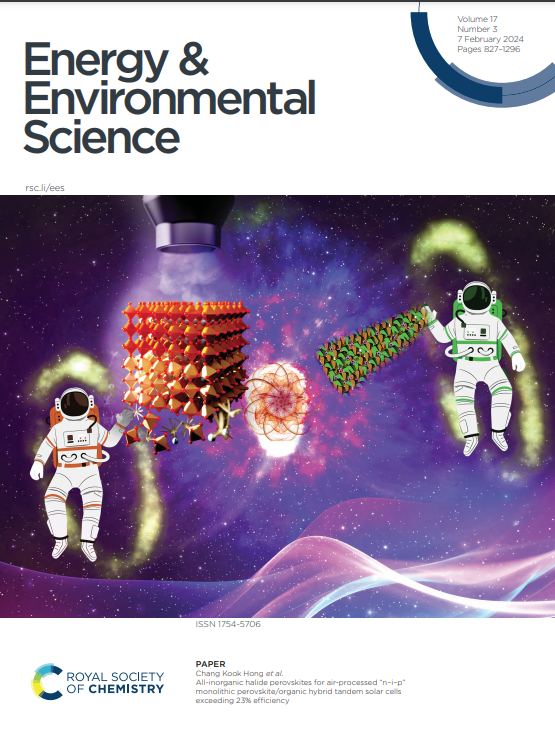Insight into the corrosion microcell and passivation mechanisms of a Zn anode for aqueous zinc-ion batteries
IF 32.4
1区 材料科学
Q1 CHEMISTRY, MULTIDISCIPLINARY
引用次数: 0
Abstract
Zinc anodes suffer from severe corrosion together with uncontrolled passivation in aqueous electrolytes, which could be aggregated during cycling of aqueous zinc-ion batteries (AZIBs). Unfortunately, the intrinsic corrosion mechanism under an electric field and its correlation with the passivation reaction remain unclear. This work revealed the spontaneous microcell corrosion mechanism of a Zn anode in a static ZnSO4 solution together with Zn dissolution and oxygen reduction via localized electrochemical analysis techniques (LEATs). It is found that the electric field could promote Zn corrosion, primarily attributed to the intensified stripping and plating heterogeneity. Synchronously, it is feasible for the high electrical field strength to trigger the heterogeneous passivation layer along with uneven Zn-ion deposition. To mitigate the self-corrosion of Zn efficiently, a zincophilic “corrosion-retarding” maskant was constructed at the Zn/ZnSO4 interface via the incorporation of (1-(3-sulphonatopropyl)pyridinium) (SPP). A Zn//Zn symmetrical cell with SPP sustains a long-term cycling of 1300 h under a high areal capacity of 20 mA h cm−2. Interestingly, Zn–I2 full cells with ZnSO4-SPP electrolyte could deliver a capacity of 138.9 mA h g−1 at 5 A g−1 after 20 000 cycles. This work provides a microscopic understanding of self-corrosion and passivation behavior of a Zn anode for rechargeable AZIBs.

水溶液锌离子电池的腐蚀微电池和锌阳极钝化机制的研究
锌阳极在水溶液中受到严重的腐蚀和不受控制的钝化,在水锌离子电池(AZIBs)循环过程中可能会聚集。不幸的是,电场作用下的内在腐蚀机制及其与钝化反应的关系尚不清楚。本研究通过局域化电化学分析技术(LEATs)揭示了锌阳极在静态硫酸锌溶液中自发微电池腐蚀机制,以及锌溶解和氧还原。结果表明,电场可以促进锌的腐蚀,主要是由于剥离和镀的非均匀性加剧。同时,高电场强度可以触发非均匀钝化层,并伴有不均匀的zn离子沉积。为了有效地减缓Zn的自腐蚀,在Zn/ZnSO4界面上通过加入(1-(3-磺化萘丙基)吡啶(SPP)构建了亲锌缓蚀体。具有SPP的Zn//Zn对称电池在20 mA h cm−2的高面积容量下可维持1300 h的长期循环。有趣的是,使用ZnSO4-SPP电解液的Zn-I2电池在5 a g−1下循环20,000次后可以提供138.9 mA h g−1的容量。这项工作提供了一个微观的理解自腐蚀和钝化行为的锌阳极的可充电的azib。
本文章由计算机程序翻译,如有差异,请以英文原文为准。
求助全文
约1分钟内获得全文
求助全文
来源期刊

Energy & Environmental Science
化学-工程:化工
CiteScore
50.50
自引率
2.20%
发文量
349
审稿时长
2.2 months
期刊介绍:
Energy & Environmental Science, a peer-reviewed scientific journal, publishes original research and review articles covering interdisciplinary topics in the (bio)chemical and (bio)physical sciences, as well as chemical engineering disciplines. Published monthly by the Royal Society of Chemistry (RSC), a not-for-profit publisher, Energy & Environmental Science is recognized as a leading journal. It boasts an impressive impact factor of 8.500 as of 2009, ranking 8th among 140 journals in the category "Chemistry, Multidisciplinary," second among 71 journals in "Energy & Fuels," second among 128 journals in "Engineering, Chemical," and first among 181 scientific journals in "Environmental Sciences."
Energy & Environmental Science publishes various types of articles, including Research Papers (original scientific work), Review Articles, Perspectives, and Minireviews (feature review-type articles of broad interest), Communications (original scientific work of an urgent nature), Opinions (personal, often speculative viewpoints or hypotheses on current topics), and Analysis Articles (in-depth examination of energy-related issues).
 求助内容:
求助内容: 应助结果提醒方式:
应助结果提醒方式:


